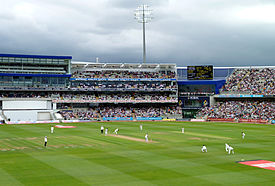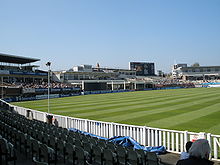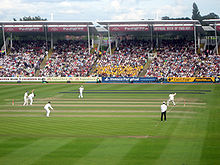- Edgbaston Cricket Ground
-
Edgbaston Cricket Ground 

Ground information Location Edgbaston, Birmingham Establishment 1882 Capacity 25,000 End names New Pavilion End
City EndInternational information First Test 29 May 1902: England v Australia Last Test 6 August 2010: England v Pakistan First ODI 28 August 1972: England v Australia Last ODI 4 July 2007: England v West Indies Domestic team information Warwickshire (1894 – present) As of 16 December 2007
Source: CricketArchiveEdgbaston Cricket Ground, also known as the County Ground or Edgbaston Stadium, is a cricket ground in the Edgbaston area of Birmingham, England. It is home to Warwickshire County Cricket Club, and is also used for Test matches and One Day Internationals.
With permanent seating for 25,000 spectators, Edgbaston is the second-largest cricketing venue in the United Kingdom, after Lord's Cricket Ground in London.[1]
Contents
History
Early history
The land that now makes up Edgbaston Cricket Ground was originally owned by the Calthorpe Estate, which had developed the manor of Edgbaston into an exclusive Birmingham suburb over the course of the 19th century, and believed that a cricket ground would be an asset that would add to the genteel image of the area.[2] Warwickshire County Cricket Club had considered Rugby and Leamington Spa for their headquarters, but club secretary William Ansell believed that Birmingham's large population and comprehensive railway connections made it preferable – envisaging first-class status for the county and test status for the ground.[2]
The club had initially favoured the Wycliffe Ground on Pershore Road, but were instead offered a 12-acre "meadow of rough grazing land" in an undeveloped area on the banks of the River Rea by the Calthorpe Estate – the less attractive development land having more to gain from association with the cricket ground.[3] With the site only 20 minutes' walk from New Street Station, Warwickshire agreed in 1885 to lease the land for £5 per acre over a 21-year period.[4] A further £1,250 was spent on draining and enclosing the site and building a wooden pavilion.[5] The new ground's first match took place on 7 June 1886 against the MCC, watched by 3,000 spectators over two days, with 6,000 turning out on 9 and 10 August to watch Warwickshire play Australia.[6]
Edgbaston's first test match was the first in The Ashes series against Australia in 1902,[7] for which the club erected a permanent stand, two temporary stands and facilities for 90 members of the press.[5] These developments cost a total of £1,500, however, and Warwickshire's share of the tour funds was only £750.[8]
Post-war development
The first piece of development in the post-war era was the construction of the Rea Bank and the Thwaite Memorial Scoreboard in 1950.[5] In 1956 an Indoor Cricket School was built[9] and the Pavilion Suite was completed in the same year.[5] By the time the William Ansell Stand opened in 1967 the facilities at Edgbaston were considered to rival those at Lord's.[5]
In 1989 executive boxes were added to the rear of the Priory and Raglan Stands and the Sidney Barnes Stand was reconstructed and enlarged, expanding the ground capacity of 17,500.[10]
In July 1997, Edgbaston was the scene of the first competitive floodlit day-night cricket match in Britain.[11]
The pavilion end on the south side of the ground was completely redeveloped between 2010 and 2011 at a cost of £32 million, partly paid for from a £20 million loan from Birmingham City Council, bringing the ground's capacity up to 25,000.[12] Demolition of the pavilion – parts of which dated back to the 1890s – and the Leslie Deakins, R. V. Ryder and William Ansell Stands took place in January 2010, with construction of the new South and West Stands starting in April 2010 and reaching completion 66 weeks later.[13] 5 permanent floodlight pylons were erected around the ground at the same time, allowing up to 15 days of day-night cricket annually.[13] The new development was officially opened by the Duke of Edinburgh on 25 July 2011.[14] The first test match to be played at the redeveloped venue was the 3rd Test vs India on 10 August 2011, which saw England reach the number 1 position in the ICC Test Championship for the first time with victory by an innings and 242 runs on the fourth day of the match.[15]
Ground
Edgbaston is considered to be one of England's leading cricket grounds. Wisden's guide to cricket grounds in 1992 commented that "Lord's is really its only superior in the United Kingdom"[10] with The Daily Telegraph agreeing in 2009 that "taken all in all, it is now the best ground outside Lord's."[16] After the opening of the new South and West Stands in 2011 the England and Wales Cricket Board commented that "the spacious facilities are cutting edge, marginally better than the Home of Cricket".[1]
The atmosphere at Edgbaston is reputed to be the most hostile in England for visiting teams.[17] Former England captain Alec Stewart recalled "On a world level I would put it up there with Eden Gardens in Calcutta, which holds about 100,000. It inspires a team. It's like having another man in your side."[17] and the former England wicketkeeper Geraint Jones describes how "The crowd here makes such a big noise when you are doing well ... it's a unique environment. Edgbaston is often referred to as "The Bullring", an English equivalent to the Wanderers ground in Johannesburg, South Africa. "[17]
The record attendance at a County Championship match at Edgbaston is 28,000 against Lancashire in the championship-winning season of 1951, and the record for a single day of a Test Match is 32,000 against the West Indies in 1957.[10]
Of all England's Test Grounds Edgbaston is the least disrupted by rain - losing an average of fewer than 90 minutes of play per match between 1979 and 1988, compared to over 8 hours per match for the most affected ground, Old Trafford.[18] For some years until 2000, Edgbaston had a distinctive motorized rain cover system, known as the Brumbrella.
Stands and spectator facilities
- South Stand
- West Stand. Built in 2011 on the site of the previous William Ansell Stand, the West Stand has two large tiers of seating. Adjacent to the south is the Edgbaston Suite – a 750 seat banqueting and exhibition space whose bright blue presence is a distinctive feature of both the inside and the outside of the ground – above which facing the pitch is a large electronic scoreboard.
- Priory Stand
- Raglan Stand
- R. E. S. Wyatt Stand. Built at the City End in 1995 and named after the Warwickshire and England all-rounder Bob Wyatt, who died that year,[19] the R. E. S. Wyatt Stand consists of a single tier of seating beneath two rows of executive boxes. Facilities in the stand include two pitch-view restaurants: the Marston's Suite and the Executive Club,[20] together with the David Heath Suite, currently used by Warwickshire members.
- Press Box Stand
- Stanley Barnes Stand. A small single tier stand opened in 1989, the Stanley Barnes Stand is situated in front of the Thwaite Memorial Scoreboard, the ground's most distinctive feature.[10]
- Eric Hollies Stand. Formerly known as the Rea Bank, after the River Rea which runs immediately to its rear, this is traditionally the most raucus area of the ground.[1] The stand was renamed after the Warwickshire and England leg-spinner Eric Hollies in 1989,[10] and was rebuilt in 2003 with 5,900 seats, an increase of 1,300 over its predecessor. The design, which won a Civic Trust Award in 2003, features a series of eight aluminium sunshades suspended over the single tier of seating on simple steel masts, appearing to hover over the crowd beneath.[21]
Notable moments
- 1957 - Stand of 411 between Peter May and Colin Cowdrey against the West Indies, England's highest-ever partnership.
- 1994 - Brian Lara scored 501 for Warwickshire against Durham, the highest score by a batsman in first class cricket.
- 1999 - Australia tie with South Africa in the 1999 Cricket World Cup semi final.
- 2004 - Marcus Trescothick becomes the first player to score a century in both innings of a test match at Edgbaston, against the West Indies. (105 & 107)
- 2005 - Australia lose to England by two runs in the 2nd Test of the 2005 Ashes, the closest Ashes match ever.
- 2008 - South Africa secure their first series win in England since 1965, chasing down 281 to win the 3rd Test, the highest ever successful pursuit at this ground. South African captain Graeme Smith scored 154* to lead his team to victory.
- 2011 - Alistair Cook scores 294 against India
See also
- List of cricket grounds in England and Wales
- List of Test cricket grounds
- List of international cricket centuries at Edgbaston
References
- ^ a b c Barnett, Rob (10 August 2011). "Edgbaston at the cutting edge". England and Wales Cricket Board. http://ecb.co.uk/news/england/edgbaston,4190,BA.html. Retrieved 15 August 2011.
- ^ a b Hignell 2002, p. 63.
- ^ Hignell 2002, p. 63-64.
- ^ Hignell 2002, p. 64.
- ^ a b c d e Pringle 1994.
- ^ Bannister 1990, p. 18.
- ^ Powell 1992, p. 443.
- ^ Ryder, Rowland (1968). "Warwickshire the unpredictable - Where cricket is always played as it should be". In Preston, Norman. Wisden Cricketers' Almanack. London: Sporting Handbooks. ISBN 0850200172. http://www.espncricinfo.com/wisdenalmanack/content/story/152384.html. Retrieved 2011-01-30.
- ^ Ryder 1973.
- ^ a b c d e Powell 1992, p. 445.
- ^ "Counter culture: Good venue guide: Edgbaston". The Guardian (Guardian Newspapers): p. 11. 1998-06-27.
- ^ Halford, Brian (2011-03-18). "It was new Edgbaston or nothing, says Warwickshire CCC chief". Birmingham Post (Trinity Mirror Midlands). http://www.birminghampost.net/midlands-birmingham-sport/west-midlands-sports/cricket-news/2011/03/18/it-was-new-edgbaston-or-nothing-says-warwickshire-ccc-chief-65233-28354959/. Retrieved 2011-08-20.
- ^ a b "Edgbaston To Become World-Leading Test And County Ground". Cricket World. Cricket World Media Ltd. 2011-05-23. http://www.cricketworld.com/edgbaston-to-be-world-leading-ground/27976.htm. Retrieved 2011-08020.
- ^ "Prince Philip marks Edgbaston Cricket Ground revamp". BBC News (BBC). 2011-07-25. http://www.bbc.co.uk/news/uk-england-birmingham-14272407. Retrieved 2011-08-20.
- ^ "England thrash India to reach summit". International Edition (CNN). 2011-08-14. http://edition.cnn.com/2011/SPORT/08/13/cricket.england.india.edgbaston.rankings/index.html. Retrieved 2011-08-20.
- ^ Henderson, Michael (2009-07-30). "The Ashes: patriotic Edgbaston makes England feel at home". Daily Telegraph (London: Telegraph Media Group). http://www.telegraph.co.uk/sport/cricket/international/theashes/5934090/The-Ashes-patriotic-Edgbaston-makes-England-feel-at-home.html. Retrieved 2011-01-24.
- ^ a b c Weaver, Paul (29 July 2009). "If Australia thought Cardiff and Lord's was noisy, they haven't heard anything yet". The Guardian (London: Guardian News and Media): p. 4. http://www.guardian.co.uk/sport/blog/2009/jul/29/ashes-edbaston-as-hostile-test-venue. Retrieved 2011-01-23.
- ^ Hignell 2002, p. 184.
- ^ Engel, Matthew, ed (1996). "Obituary - Bob Wyatt". Wisden Cricketers' Almanack. John Wisden & Co.. ISBN 0947766316. http://www.espncricinfo.com/wisdenalmanack/content/story/154191.html. Retrieved 2011-08-20.
- ^ Keith Prowse 2011, p. 6.
- ^ "Eric Hollies Stand, Edgbaston". Work. Bryant Priest Newman Architects. http://bryantpriestnewman.com/work/entry/eric_hollies_stand_edgbaston_county_cricket_ground. Retrieved 2011-08-20.; "Eric Hollies Stand, Warwickshire County Cricket Club". www.SteelConstruction.org. British Constructional Steelwork Association. 2003. http://www.steelconstruction.org/resources/design-awards/2003/certificate-of-merit/eric-hollies-stand-warwickshire-county-cricket-club.html. Retrieved 2011-08-20.
Bibliography
- "2011 Edgbaston" (pdf). Keith Prowse. 2011. http://view.vcab.com/fs/00000320/00024975/00186191/_uploads/Egbaston%20Brochure%20-%20VCAB%204.pdf. Retrieved 2011-08-22.
- Bannister, Jack (1990). The history of Warwickshire County Cricket Club. London: Christopher Helm. ISBN 0747002177.
- Hignell, Andrew (2002). Rain stops play: cricketing climates. London: Routledge. ISBN 0714651737. http://books.google.co.uk/books?id=A5BRrWToEVwC. Retrieved 2011-02-02.
- Powell, William (1992). The Wisden Guide to Cricket Grounds. London: Stanley Paul. ISBN 0091771889.
- Pringle, Derek (1994-08-07). "Arena: Pioneers with grand ambition: 16 Edgbaston: Derek Pringle traces the history of a county and Test cricket ground which is laced with controversy". The Independent (London). http://www.independent.co.uk/sport/arena-pioneers-with-grand-ambition-16-edgbaston-derek-pringle-traces-the-history-of-a-county-and-test-cricket-ground-which-is-laced-with-controversy-1374761.html. Retrieved 2011-02-02.
- Ryder, Rowland (1973). "The Warwickshire way - What is it that makes Warwickshire tick?". In Preston, Norman. Wisden Cricketers' Almanack. London: Sporting Handbooks. ISBN 0850200288. http://www.espncricinfo.com/wisdenalmanack/content/story/152469.html. Retrieved 2011-02-02.
External links
Coordinates: 52°27′20.93″N 1°54′08.96″W / 52.4558139°N 1.9024889°W
Buildings and structures in Birmingham, England Highrise
(in height order)Notable lowrise - 1–7 Constitution Hill
- 17 & 19 Newhall Street
- Assay Office
- Aston Hall
- Barber Institute of Fine Arts
- Baskerville House
- Blakesley Hall
- Central Library
- St. Chad's Cathedral
- Council House
- Curzon Street station
- Great Western Arcade
- ICC
- Island House
- St Martin in the Bull Ring
- Methodist Central Hall
- Millennium Point
- NIA
- Old Crown
- Perry Bridge
- St. Philip's Cathedral
- Pebble Mill Studios
- Proof House
- Sarehole Mill
- Symphony Hall
- Town Hall
- Victoria Law Courts
Major railway stations Hospitals - Queen Elizabeth
- Old Q.E.
- Selly Oak
- Good Hope
- Children's
Major hotels - Hyatt Regency
- Radisson Blu
Major complexes Sports venues - Alexander Stadium
- Edgbaston Cricket Ground
- Edgbaston Priory Club
- St Andrew's
- Villa Park
- Tallest
- Board schools
- Listed
- Category
Test cricket grounds in England and Wales Current Test grounds: Edgbaston · Headingley · Lord's · Old Trafford · The Oval · Riverside · Sophia Gardens · Trent Bridge · Rose BowlFormer Test grounds: Categories:- Sport in Birmingham, West Midlands
- Cricket grounds in the West Midlands (county)
- 1882 establishments
- Buildings and structures in Birmingham, West Midlands
- Test cricket grounds in England
Wikimedia Foundation. 2010.


